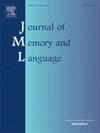Type and token frequency jointly drive learning of morphology
IF 3
1区 心理学
Q1 LINGUISTICS
引用次数: 0
Abstract
We examine the joint roles of type frequency and token frequency in three artificial language learning experiments involving lexicalized plural allomorphy. The primary role of type frequency in productivity is well-established, but debates about the precise relationship between type frequency and productivity continue. The effect of token frequency on productivity is even more controversial: some lines of research suggest token frequency and productivity are inversely related, other results indicate they are positively related, and yet others argue token frequency plays no role in productivity. We address both of these questions. Our learning framework makes it possible to examine the effects of these variables on generalization to novel forms and to examine how sensitivity to these factors affects the time-course of learning. The first two experiments differentiate predictions for generalization of three distinct hypotheses about the role of type frequency, while the third experiment investigates the independent role of token frequency. We find that both type and token frequency independently and positively contribute to learning rates and generalization across the three experiments. We also apply two computational learning theories – implementing two prominent theoretical linguistic frameworks – to the learning of the lexically-conditioned allomorphy patterns in our experiments. Despite their differences, we show that the incremental learning dynamics of both models correctly predict the general trends in generalization rates, learning curves, and the influence of token frequency observed across the experimental conditions.
词型和词频共同驱动词法学习
在三个涉及词汇化复数异型的人工语言学习实验中,研究了类型频率和标记频率的联合作用。类型频率在生产力中的主要作用是公认的,但关于类型频率和生产力之间确切关系的争论仍在继续。代币频率对生产力的影响更具争议性:一些研究表明代币频率和生产力呈负相关,其他结果表明它们呈正相关,还有一些人认为代币频率对生产力没有作用。我们解决了这两个问题。我们的学习框架可以检验这些变量对新形式泛化的影响,并检验对这些因素的敏感性如何影响学习的时间过程。前两个实验区分了关于类型频率作用的三个不同假设的泛化预测,而第三个实验研究了标记频率的独立作用。我们发现类型和标记频率对三个实验的学习率和泛化都有独立和积极的贡献。我们还应用了两种计算学习理论-实现了两种突出的理论语言学框架-在我们的实验中学习词汇条件异形模式。尽管它们存在差异,但我们表明,两种模型的增量学习动态都正确地预测了在实验条件下观察到的泛化率、学习曲线和标记频率影响的总体趋势。
本文章由计算机程序翻译,如有差异,请以英文原文为准。
求助全文
约1分钟内获得全文
求助全文
来源期刊
CiteScore
8.70
自引率
14.00%
发文量
49
审稿时长
12.7 weeks
期刊介绍:
Articles in the Journal of Memory and Language contribute to the formulation of scientific issues and theories in the areas of memory, language comprehension and production, and cognitive processes. Special emphasis is given to research articles that provide new theoretical insights based on a carefully laid empirical foundation. The journal generally favors articles that provide multiple experiments. In addition, significant theoretical papers without new experimental findings may be published.
The Journal of Memory and Language is a valuable tool for cognitive scientists, including psychologists, linguists, and others interested in memory and learning, language, reading, and speech.
Research Areas include:
• Topics that illuminate aspects of memory or language processing
• Linguistics
• Neuropsychology.

 求助内容:
求助内容: 应助结果提醒方式:
应助结果提醒方式:


